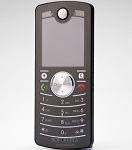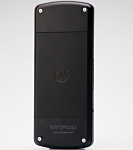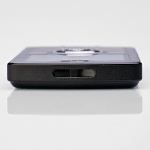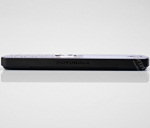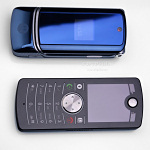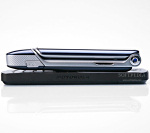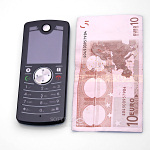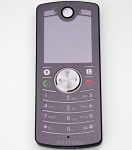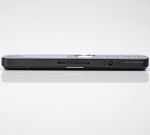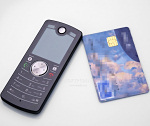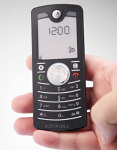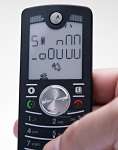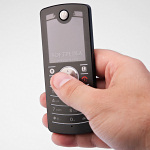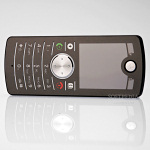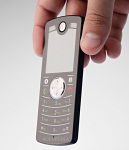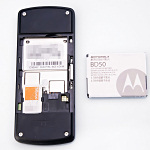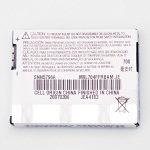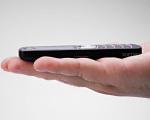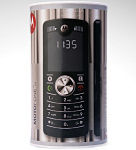Besting Nokia, Sony Ericsson and Samsung all over America, with its RAZR-like design, Motorola decided to apply the successful form factor to a low-end handset: Motorola F3. What can anyone do to drastically reduce the cost of a newly launched mobile phone, but at the same time raise its desirability? Well, I'll tell you what Motorola did: it replaced the usual color display with a monochrome alphanumeric screen, it eliminated all the features of a mobile phone except the SMS, and applied the RAZR-like design to an already slim form. The result was a simplified, almost primitive handset, but by all standards a good-looking one.
Announced in Q2 2006, MOTOFONE F3, as it's widely known, has been launched on the market in India in November 2006. At the time of its launch, the phone's price was a little bit overrated, Motorola charging buyers with almost 45 Euros; but today, the handset can be acquired for only 50 USD.
Design
The reason that Motorola mobile phones are selling better than other renowned brands stands mainly in their exquisite designs. Since Motorola's RAZR model started to sell, almost every new handset launched borrowed some of its form factor, which stands out from the crowd through slimness and glamorousness. At only 9 mm thickness, Motorola's F3 is a wonder for a low budget mobile phone. The rest of its coordinates, 114 x 47 mm and 70 grams (including battery) weight, are simply placing the phone ahead of most of the other brands of low-end handsets in terms of design.
The "sweet" candy-bar form is doubled by a RAZR-like keyboard with big and easy to use keys. Unfortunately, because of its "primitive" construction, the phone is "buttonless" and doesn't feature any external keys except the charging port, which can be used to attach headsets. Also, the material used for manufacture is mostly pure plastic, which is understandable because Motorola chose the cheapest solution possible.
Display and Camera
The candybar phone from Motorola is the first mobile to use electronic papers in its screen. The alphanumeric monochrome display measures 34 x 43 mm and features extra large character font size. As Motorola named this technology, ClearVision provides the phone's display with a good visibility outdoors because of its extremely high contrast. The supplier of this technology was E Ink Corporation, a well-known manufacturer of electronic paper displays. Besides the good visibility in brighter areas, the new tech offered Motorola the possibility to replace the usual glass display with a thinner one made of plastic.
The keypad's backlighting system is the only thing that illuminates the display in darker areas, which makes it a very low power consumer. Unfortunately, because of the extra large font size the screen can only display two rows of text which makes it rather unpractical for SMS-ing or text reading. A strange feature of the screen is that if you take out the battery it will still display the last readable characters before cutting the power.
Obviously, the phone doesn't feature anything that could resemble a camera. Again understandable if we think that with a camera, the low-end phone wouldn't be one of the cheapest handsets available on the market at the moment.
Menu and Software
The menu of the phone, while simple enough, it could be a pain to use. At first glance, you'll probably think that you can't do too many things without an obvious "Menu" key to help navigate through different options and commands. Well, actually, if you don't pay attention to the guide that comes in the sales package, you'll continue to believe that soon enough you'll give up the phone. The safest option is to read the guide provided with the phone and follow the exact instructions supplied whenever you want to customize your MOTOFONE F3.
Every time you'll turn on the phone you'll be asked if you would like vocal assistance in using it (it can be disabled). If you choose to benefit from this feature, the big 5-way wheel used for navigation through some of the simple commands (ringtones, time settings, alarm, call history and phonebook) will be "spoken" to you, assuming that you don't understand the icons that every command is represented by. The vocal assistance will help you setup your clock, change your ringtone or write a text message. I think this optional feature should be extremely helpful for people with disabilities.
There are also some complex commands - depending on your cellular network operator - that are accessible through different number combinations that also include signs like # or *. In case you want to change the language, the time format or your PIN code, you'll have to check the paper guide in the sales package for the right combination. A good example should be the "Quick dial" command that can be activated by pressing for 2 seconds the number on the keypad that corresponds to the first 9 contacts in your phonebook. For the rest of the contacts, you will need to introduce the position number of your SIM contact and then press the # key (e.g. 12#).
Communication
The only way to communicate with the dual band (GSM 900 / 1800) handset, besides calling someone, is through SMS. Less practical than other phones that feature an LCD display, text messaging with this mobile could be a pain because you won't be able to read/write more than six characters in a line. Other than that, there are no other connectivity features, but those that will buy the phone won't need any of those.
For a low-end phone, the signal reception is pretty good, but we have experienced some distortions of the sound when speaking on the phone.
Multimedia
The phone features 8 channels polyphonic sounds and includes 7 pre-installed ringtones. You can choose any of the ringtones, but I suggest you to opt for the vibration alert, as the sound is awful (like in "horrible"). Why Motorola didn't include at least mediocre ringtones beats me, but these are "junkier" than the junk. As you might guess, you can't erase them and you can't install new ones.
Battery
The official numbers for the 800 mAh Li-Ion battery included are 300 hours in standby mode and 4 hours and 30 minute of talk time. Actually, the phone's battery lasted a little bit over 5 days with about 20 minutes of talk time everyday. Overall, the performance was good, but we haven't expected any less, because the phone has been developed as a low power consumption device.
Impressions
If I were to express my personal opinion about the phone, it won't be too fair, as I'm more attached to multipurpose mobile phones. So I decided to ask around people that are not so much into mobiles and the overall opinion was pretty good. It seems that THE LOOK and THE PRICE did all the work and Motorola scored another hit on the market with its "paper phone".
The Good
The touch of Motorola designers is pretty obvious in this case and the thickness of the device cannot be overlooked (and it won't be either). Even if slim doesn't necessary mean good-looking, the RAZR-like design, backed by a very "interesting" price will sell MOTOFONE like crazy.
The Bad
Maybe a little bit more work on the ringtones and display would've been "healthier" for the buyers. But as it has been done, unless you have no ear for music, you'll hate your call ringtones and will most probably learn to "feel" your F3 instead of "hearing" it. Also if the screen could've displayed more characters on a line that should've made owners write/read text messages easier.
Sales Package
Motorola F3 handset Motorola 800 mAh battery Charger User manual
Photo: Tudor Raiciu for Softpedia.com
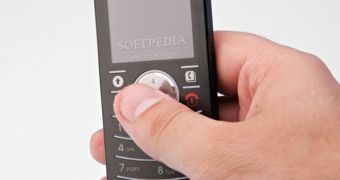
 14 DAY TRIAL //
14 DAY TRIAL // 